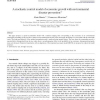Free Online Productivity Tools
i2Speak
i2Symbol
i2OCR
iTex2Img
iWeb2Print
iWeb2Shot
i2Type
iPdf2Split
iPdf2Merge
i2Bopomofo
i2Arabic
i2Style
i2Image
i2PDF
iLatex2Rtf
Sci2ools
AUTOMATICA
2006
2006
A stochastic control model of economic growth with environmental disaster prevention
This paper proposes a capital accumulation model with a random stopping time corresponding to the occurrence of an environmental catastrophe. Depending on the preventive capital stock accumulated at the time of the catastrophe, the damage cost associated with the catastrophe varies. The long-term behavior of the optimal accumulation path is analyzed using turnpike theory. The case where the catastrophe process is uncontrolled is distinguished from the case where there is an anthropogenic effect on the probability of an occurrence. Intergenerational equity issues are discussed. Numerical experiments with an adaptation of the integrated assessment model DICE94 are proposed to explore the model responses. 2005 Elsevier Ltd. All rights reserved.
AUTOMATICA 2006 | Capital Accumulation Model | Environmental Catastrophe | Optimal Accumulation Path |
| Added | 10 Dec 2010 |
| Updated | 10 Dec 2010 |
| Type | Journal |
| Year | 2006 |
| Where | AUTOMATICA |
| Authors | Alain Haurie, Francesco Moresino |
Comments (0)

